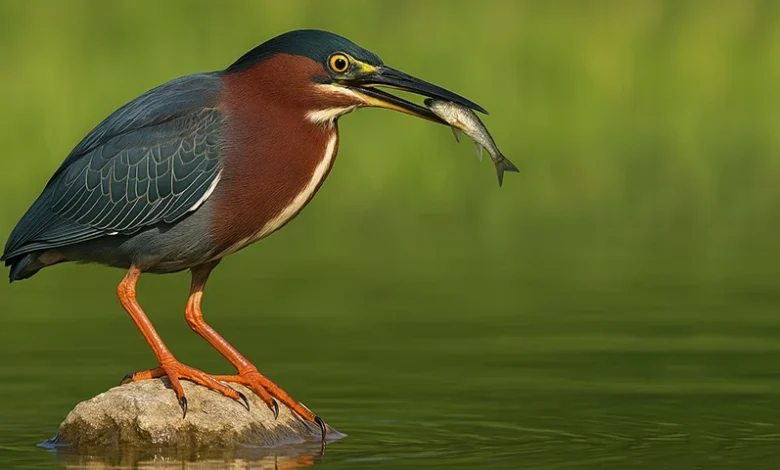Green Heron (Kalali)

The Green Heron (Butorides virescens) locally known as “Kalali”, is a small, stocky wading bird often seen along the wetlands, riverbanks, and mangrove-lined coasts of Dominica. Recognisable by its deliberate hunting behavior and bold plumage, this secretive bird blends perfectly with the island’s lowland aquatic habitats, offering quiet drama to those who know where—and how—to look.
Appearance and Identification
Compact in size, the Green Heron stands about 44 cm (17 inches) tall. Adults have a rich greenish-black cap, chestnut-colored neck, and gray-green wings with a slight iridescent sheen. Its sharp yellow eyes and dagger-like bill aid in stealthy fishing. Juveniles are browner with streaked necks and spotted wings. The bird often adopts a hunched posture when perched or stalking prey.
Habitat and Distribution in Dominica
The Green Heron is a year-round resident in Dominica’s low-elevation wetlands and coastal zones. Preferred locations for sightings include:
- Indian River and Glanvillia (Portsmouth) – Look for them among mangrove roots and shaded riverbanks.
- Cabrits National Park – Particularly around swampy inlets and backwater lagoons.
- Layou River and Roseau River – A known feeding ground where they perch on logs or wade in shallow water.
- Castle Bruce and Rosalie Bay – Coastal wetlands and estuarine environments provide ideal hunting spots.
Behavior and Birdwatching Tips
The Green Heron is best known for its patience and stealth. It feeds on small fish, frogs, aquatic insects, and crustaceans, striking quickly with its bill after motionless stalking. Remarkably, it is one of the few bird species known to use tools—dropping insects or twigs on the water surface to lure fish.
Birdwatching tips:
- Visit early morning or late afternoon when feeding activity is high.
- Look for movement near river edges, ponds, or roots in shadowy areas.
- Be quiet and still—this heron is shy and quick to fly if startled.
- Local guides around Indian River or Layou Valley can assist with spotting it among reeds or branches.
Nesting and Local Status
Nests are built in trees or shrubs near water, made from twigs and usually well-hidden. The female lays 3–5 eggs, with both parents involved in incubation and feeding. While not endangered, the Green Heron’s dependence on wetland habitats makes it vulnerable to habitat degradation and pollution.
The Green Heron is a subtle but fascinating resident of Dominica’s watery landscapes. For keen-eyed birdwatchers and nature lovers, it offers one of the island’s most graceful aquatic encounters.




